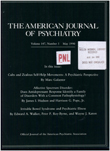Anterior pituitary, adrenal, and gonadal hormones during cocaine withdrawal
Abstract
Plasma luteinizing hormone (LH), prolactin, testosterone, and cortisol levels were determined in 16 patients after hospital admission for cocaine abuse, during the course of 4 weeks of hospitalization, and before discharge. Hyperprolactinemia was found at admission (mean +/- SD, 27.5 +/- 10.2 ng/ml) and persisted until discharge (mean +/- SD, 28.7 +/- 10.8 ng/ml). Plasma LH, testosterone, and cortisol levels were within normal limits. These findings suggest that persistent elevation of plasma prolactin levels after cocaine withdrawal may reflect a chronic cocaine-induced derangement in neural dopaminergic regulatory systems.
Access content
To read the fulltext, please use one of the options below to sign in or purchase access.- Personal login
- Institutional Login
- Sign in via OpenAthens
- Register for access
-
Please login/register if you wish to pair your device and check access availability.
Not a subscriber?
PsychiatryOnline subscription options offer access to the DSM-5 library, books, journals, CME, and patient resources. This all-in-one virtual library provides psychiatrists and mental health professionals with key resources for diagnosis, treatment, research, and professional development.
Need more help? PsychiatryOnline Customer Service may be reached by emailing [email protected] or by calling 800-368-5777 (in the U.S.) or 703-907-7322 (outside the U.S.).



